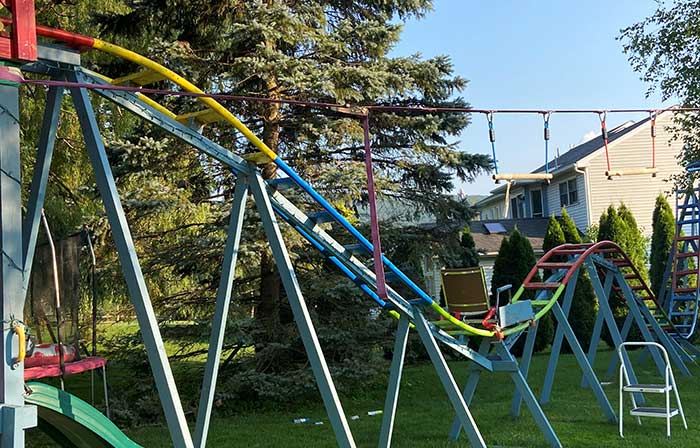Front Yard Mission: Helping people love their neighbors
Troy Emenecker
Guest writer
Point Magazine // September 2021
In September 2020, my wife, Kristin, our 6-year-old daughter and I moved into our current house in Queen Creek, a town roughly 35 miles southeast of Phoenix. Since we purchased the home with plans to remodel, interaction with our soon-to-be-new residence and neighborhood was reduced to dropping off materials in the garage, throwing away junk mail and hoping the plans were on schedule for a Labor Day weekend move.
Along the way, we met the mom who lived next door, and we introduced ourselves. A man in a red truck who lived at the end of the street pulled over long enough to introduce himself and offer his services whenever we moved in.
The kicker, though, was the day of the move. Armed with the most giant U-Haul in the state, we pulled up to our house. I had no more than unlocked and opened the back of the truck when a guy I had never met, in his mid-30s, jumped into the truck and started pulling down boxes, and then furniture, and asking where they went.
I came to find out this was my next-door neighbor, husband to the woman we had met a month earlier and father to five kids under the age of 11. About 20 minutes later, the truck empty, he returned to his house as quickly as he had arrived.
Related: The art of neighboring
That morning, a man on a golf cart and holding a dog stopped by. He lived on the street behind us, and we soon learned his daughter and ours shared the same kindergarten class at the elementary school two blocks away. An older couple across the street introduced themselves as well, the mom and my wife sharing the same name.
Is there something in the waters of our neighborhood, causing families young and old to magically congregate in their front yards ― a selfless community where, as the saying goes, “everybody knows your name”? Well, it’s certainly not the water, which is as hard as rock in Arizona.
More seriously, though, what if a neighborhood “looked” like the scene described above, opened its arms as it did a year ago for us, found common ground on which to stand as a community?
Leading, loving and learning
And so beats the heart of Front Yard Mission, a ministry originating in State College, Pennsylvania. Its founders see it as more than simply a mission. To them, it’s the gospel in everyday life.
“When we look at Scripture, we see Jesus calling his disciples to follow, and as he is sending them out, he continues teaching them,” said Dan Nold, lead pastor of Calvary Church’s five campuses in the central Pennsylvania area. “In the same way, we are called to do the same: to show love to our neighbors as we are continuing to be discipled.”
Related: Who are the people in your circles of influence?
Several years ago, Nold and other regional pastors developed a “2030 vision” of doubling Central Pennsylvania Jesus-followers by 2030. Within that movement, Nold said, was a vision for a “single track for believers, where everybody’s a leader.” Leading included showing love to five neighbors for 40 days, hoping to lead one to Christ.
It began as a sermon about moving the church beyond the walls of Sunday morning. And it gradually evolved into a movement that empowered congregation members to serve, and all from the comfort of their front yard.
A calling to the local mission field
Jonathan Weibel, who Nold brought to Calvary to help spearhead Front Yard Mission, calls the ministry an extension of Luke 10, in which, ahead of his arrival at the towns, Jesus sends out his disciples in pairs.
“We talk about connecting with others on a global level, which typically we think of as the mission field,” he said. “But the local level is just as much where we are called.”
Related: Beyond your doorstep
Nold calls Weibel a “gatherer…he lives, eats and breathes neighboring.” Five minutes into a conversation, it’s clear the former youth pastor and church planter desires to love his neighbors. Shortly after moving into his current home, Weibel found common ground with his neighbor through a firepit they built together on the line where their property meets.
Recently, he cut a path through the trees on one end of his multi-acre property because his elderly neighbor enjoyed seeing people come over to Weibel’s house.
Regardless of the situation, Weibel believes connecting with one’s neighbors can best happen with guidance from church leaders, which is why he made the mission his full-time job earlier this year.
“People like to say that getting to know those around them must happen organically, but it needs some structure to actually form,” Weibel said.
The method is simple: invite a neighbor into your space through a conversation, a meal, a game night; invite them into your life by creating time to talk, not necessarily about your faith but just about their lives; invite them into the life of Christ, which Weibel said should be the believer’s ultimate goal in every relationship.
At an “everyday” level, this can look like a lot of things: setting up tables in someone’s front yard and inviting a handful of people over, whether it be for donuts and coffee, grilling brats, or making pizzas; a movie night using a blanket hung from a garage door as a projection screen; setting up chairs around a fire-pit in the driveway on Halloween; a cornhole tournament.
Calvary distributes a monthly events menu highlighting each of the above possibilities ― season and weather permitting ― as well as event invitations church members can easily hang on their neighbors’ doors.
The “tribal” component of Front Yard Mission extends the events for those not living in a traditional neighborhood. Affinity groups can gather either in a neutral location or online, brought together by a common interest.
Forty “shepherds” regularly connect with the neighborhoods and communities with the Central Pennsylvania region to offer support, pray for residents and further the discipleship necessary to continue development. Meanwhile, Nold said, about a dozen pastors from neighboring churches meet weekly to unify the movement.
“This vision is certainly transferable to other churches,” he said. “It’s not a Calvary vision ― it’s a citywide vision, a regional vision. It doesn’t need our name on it.”
Sharing the vision with other churches
With Calvary still meeting remotely during the Christmas season, Front Yard Mission organized and promoted a Christmas Eve service church members could host in their neighborhoods. As a result, 27 services took place in front yards through the region, where about 25 attendees sang Christmas carols, lit candles and ate cookies. Most important, there was no catch.
“Non-churchgoers are generally receptive to church on Christmas Eve, but we deliberately didn’t want a bait-and-switch element to these gatherings,” said Steve Lutz. He hosted a Christmas Eve service in his front yard and is the other face behind the ministry. Oh, and he built a rollercoaster on his property for anyone who wants to come over and ride.

Lutz oversees Calvary’s Digital Discipleship ministry, which has helped extend Front Yard Mission’s message past the State College borders. He aims to provide church leaders the tools they need in an easily accessible manner, enabling them to develop and further their own versions of the movement.
“In the past, you would unload a bunch of content onto a website and hope others would somehow get it,” Lutz said. “Hopefully, we’re sharing our knowledge and experiences in a way that is relatable and applicable to where the leaders are.”
Among these are training modules offered online and through text message, as well as a 6-week training class, which Lutz said has connected 25 leaders from across the country. In addition, a podcast is in the works, and Weibel and Lutz are releasing a book this year, Front Yard Mission. All these efforts are furthering their calling to move the ministry into something bigger than a trend or a multi-week series.
“Front Yard Mission, it’s discipleship,” Lutz said. “We want the thinking to shift from ‘episodic’ to ‘Front Yard Christmas,’ and then to ‘normal rhythm,’ where this is just what we do.”
During the height of the COVID pandemic, Lutz said, the emphasis at the Front Yard Mission and Calvary Church level remained relatively the same.
“Be still and know, love God and love your neighbor,” he said. “That’s what we continued to preach.”
A bold move ruffles feathers
Since returning to in-person services, Calvary has designated the fourth Sunday of the month as Church Without Walls (CWOW) Sunday. Churchgoers are encouraged to invite a neighbor or friend to watch the online-only service and create opportunities to continue building relationships in their neighborhoods. The August focus for CWOW was to “Bless the next generation” by praying for a nearby school, blessing a teacher in the neighborhood, providing school supplies or a gift card for new clothes to a family or hosting an end-of-summer movie night for kids.
Related: No time to waste: Do you love Jesus so much that you can’t wait to tell others about him?
Nold called the CWOW move a bold one that “ruffled a lot of feathers,” but was necessary to reiterate the church’s role as a movement rather than just a facility.
“We call on our congregation to be leaders in their communities, and this is what that looks like,” Nold said.
Ultimately, Weibel wants the community and those outside it to recognize the passion behind his and Lutz’s efforts.
“This thing we’re doing, we don’t want people to think it’s that big of a deal,” he admits. “We want them to see that the gospel calls them to be known for how they love and to really believe it in a way that compels them to do so.”
Troy Emenecker, Guest writer
Troy Emenecker is a freelance writer for Converge. He attends a Converge church in Mesa, Arizona.
Additional articles by Troy Emenecker

